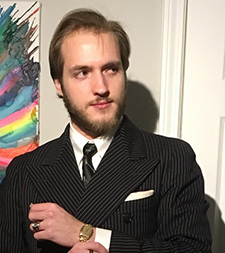Engineers are often asked to find solutions for difficult problems. Other times, the solution is only a first step.
 Martin Holland earned his B.S. and M.S. degrees in mechanical engineering from UAB. He currently works at EITD and is a student in the Interdisciplinary Engineering Ph.D. program.When David Askenazi, M.D., recognized a need in neonatal care, he began working on a solution. Later, with a potential solution in hand, his team needed a prototype to test the viability of their idea. For that, they needed an engineer.
Martin Holland earned his B.S. and M.S. degrees in mechanical engineering from UAB. He currently works at EITD and is a student in the Interdisciplinary Engineering Ph.D. program.When David Askenazi, M.D., recognized a need in neonatal care, he began working on a solution. Later, with a potential solution in hand, his team needed a prototype to test the viability of their idea. For that, they needed an engineer.
Askenazi, a professor in the UAB Department of Pediatrics and director of the Pediatric and Infant Center for Acute Nephrology at Children’s of Alabama, approached the School of Engineering’s Engineering Innovation and Technology Development (EITD) group about making a device that would capture urine from patients in the neonatal intensive care unit.
EITD engineer Martin Holland took on the project, and over the past year, Holland has created a number of prototypes of the device--called ZorroFlow--using 3-D printers from the School of Engineering's Undergraduate Design Lab.
“I’ve done a lot of jobs where someone brought us a vague idea, and we had to work from the ground up,” said Holland. “With this one, Dr. Askenazi’s team already had a fully formed idea. The first time we met, they showed me a number of sketches of what they wanted the device to look like and how they wanted it to work. I was pleasantly surprised.”
 The problem the team was attempting to address, Holland explained, was developing a better method of capturing urine from patients in the neonatal intensive care unit. “There are two methods currently in use—diapers and catheterization,” he said. “Catheters can cause infection, but diapers limit the doctors’ ability to measure urine output and to preserve urine for testing. So neither option is ideal.”
The problem the team was attempting to address, Holland explained, was developing a better method of capturing urine from patients in the neonatal intensive care unit. “There are two methods currently in use—diapers and catheterization,” he said. “Catheters can cause infection, but diapers limit the doctors’ ability to measure urine output and to preserve urine for testing. So neither option is ideal.”
Now that multiple prototypes have been built and tested, Holland says the next step is to identify a manufacturer to produce the large number of devices needed for the more rigorous testing that comes prior to FDA approval.
The project is a significant diversion from Holland's usual simulation work with EITD and his coursework as a student in UAB’s Interdisciplinary Ph.D. program. But far from being a distraction, he said his work with Dr. Askenazi’s team is an example of what makes UAB such a unique place. “As a mechanical engineer, you don’t expect to be doing a lot of work with neonatal medical devices,” he said. “But these are the types of opportunities we get a lot at UAB. There is so much specialized knowledge here, and when researchers start to build teams to address a challenge, there is usually a spot for an engineer.”